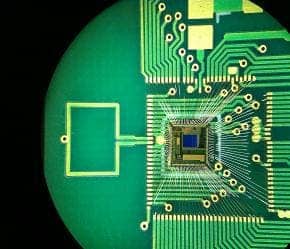Biologists at Tufts Universityand University of Minnesota showed for the first time that bioelectricity signaling between cells guides embryonic brain development in tadpoles. When bioelectricity signaling was hampered, the frog embryos developed abnormal brains. By using drugs that target specific ion channels, the researchers could restore normal patterns to ensure healthy brain growth. This means that careful manipulation of electricity inside the tissue can repair abnormalities caused by genetic defects. It can also be used to grow all sorts of wacky stuff.

Previously Tufts University developmental biologist Michael Levin manipulated cells’ electrical potential by inducing a specific current gradient to cause tadpoles to sprout extra limbs, tails or functioning eyes. The idea that electrical gradients across tissue can direct growth and form of organisms isn’t quite new, in fact. It can be traced back to the 1930s when Dr. Harold S. Burr of Yale University found abnormal growth (such as cancer) was preceded by the appearance of abnormal voltage gradients in an organ.
Harnessing and manipulating bioelectricity at a more complex level is quite new however, sprouting a new emerging field called bioelectronics which studies naturally occurring electric fields in biological systems. Some of the most exciting research from the field found, for instance, that certain pulsed electric fields can wipe out skin tumors in mice. Melanoma, is an extremely aggressive disease that kills about 8000 people a year in the United States alone, but a few hundred pulses totaling just 120 microseconds of treatment shrank tumors in mice by 90 percent. A second treatment, days later, destroyed the tumors completely.
Levin’s research adds a further dimension to the importance to the flow of electric field inside cells, suggesting they’re just as essential to a tissue’s growth blueprint as much as DNA is.
“We’ve found that cells communicate, even across long distances in the embryo, using bioelectrical signals, and they use this information to know where to form a brain and how big that brain should be,” says Levin, who holds the Vannevar Bush Chair in biology and directs the Center for Regenerative and Developmental Biology in the School of Arts and Sciences at Tufts University. “The signals are not just necessary for normal development; they are instructive.”
First, the biologists genetically modified tadpole brain cells such that they would form additional ion channels in the membrane. These channels allow charged molecules and atoms to travel in and out of the membrane. More channels, means these ions can cross more easily thereby reducing the cell’s overall polarity. The reduced charge caused certain brain regions to grow smaller; some completely failed to develop. These led them to conclude that disruptions in ion channel patterns might explain many brain development defects.
To illustrate, the team tested the bioelectrical blueprint elsewhere in the body. Previously, the grew extra limbs or eyes. This time, while they didn’t grow an extra brain, the team successfully generated neuronal growth in locations far from the brain. Moreover, when they used drugs to compensate the mismatched bioelectric patterns inside the developing brain, tadpoles eventually showed healthy brain growth, as reported in The Journal of Neuroscience.
There are numerous babies born with brain defects, as a result of abnormal development. This research clearly shows that it’s possible not only to correct defects, but also heal the brain in the case of neurodegenerative diseases.
“These are issues in brain development that people never talk about,” Levin says. “This work could provide a road map for new approaches.”
“Additional study is needed to understand more fully the mechanisms by which electric signaling interacts with genetic networks. However, here we show two such steps, involving calcium signaling and cell-cell communication via electrical synapses known as gap junctions.
“We are working on applying these techniques in biomedical contexts, especially ion channel modulating drugs — electroceuticals — to repair defects and induce brain regeneration.”





